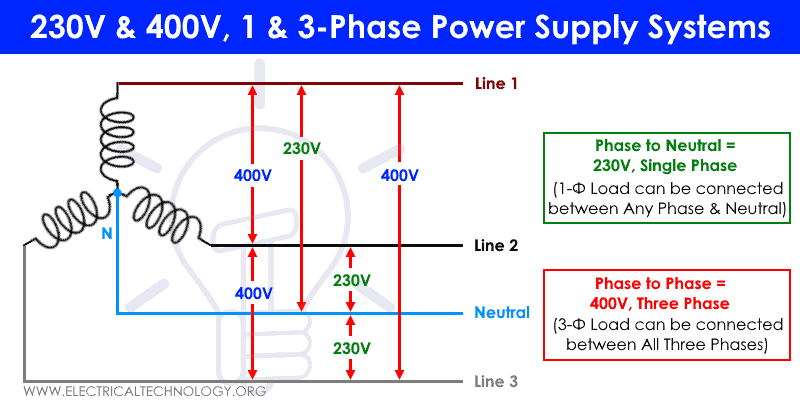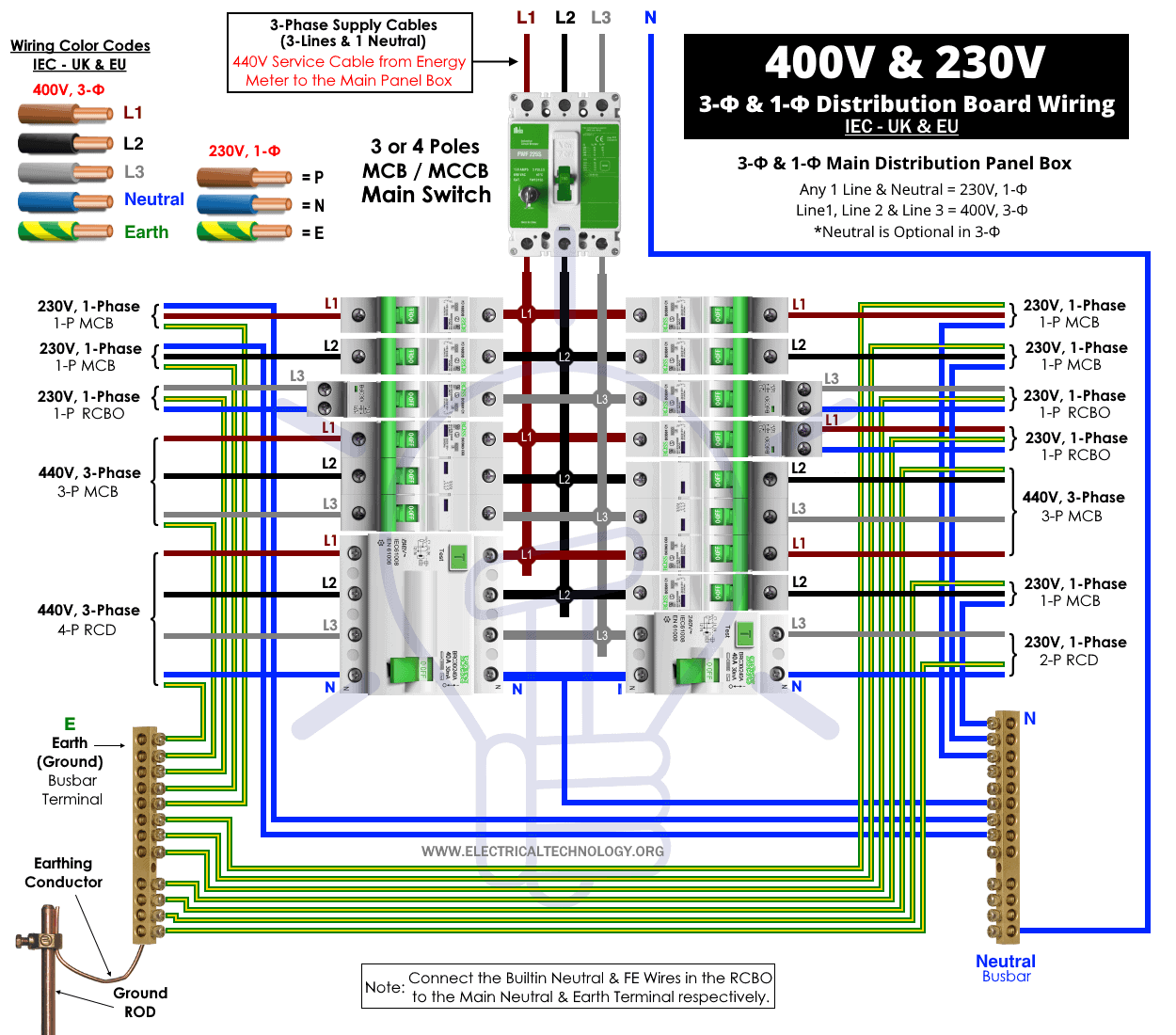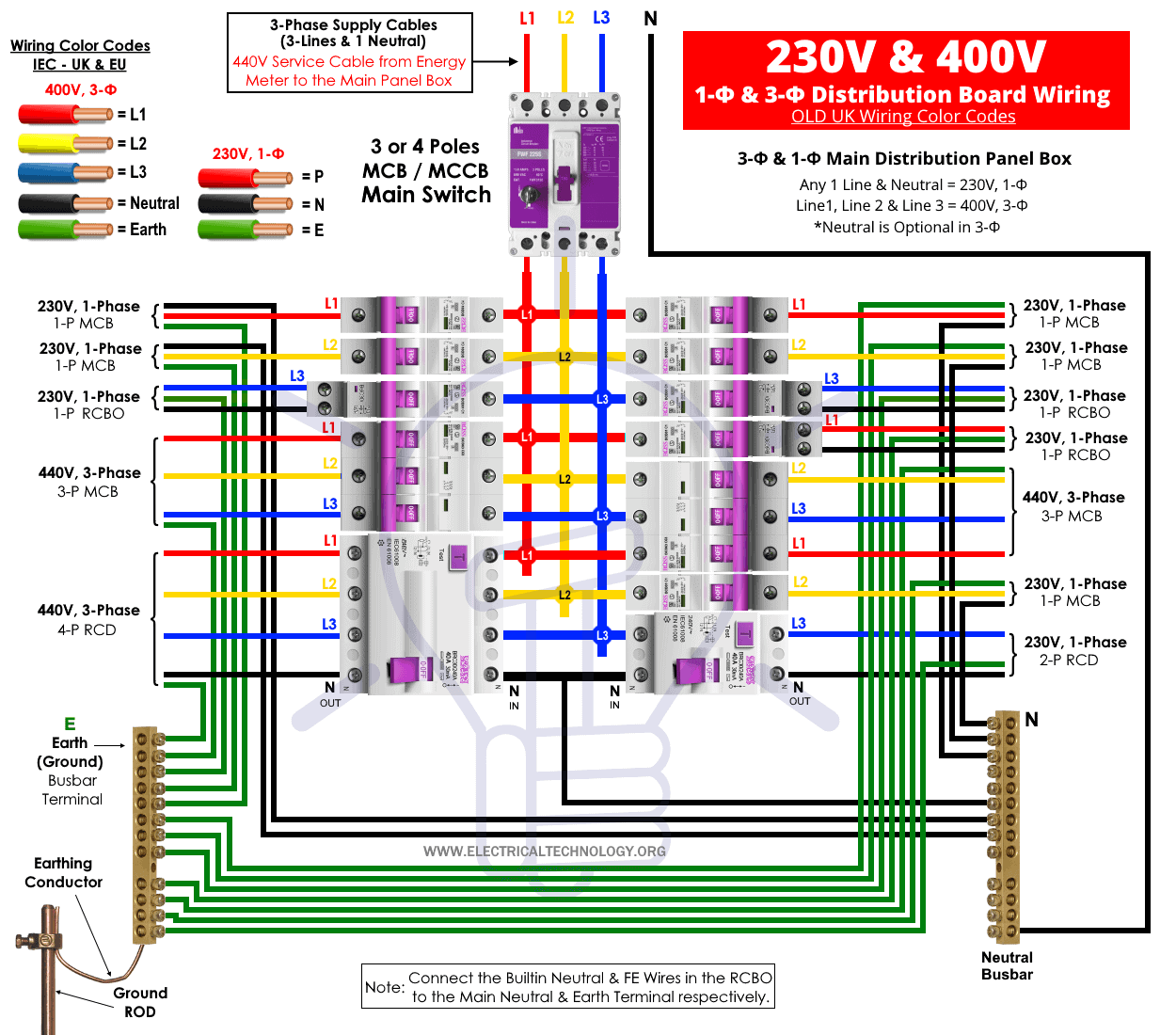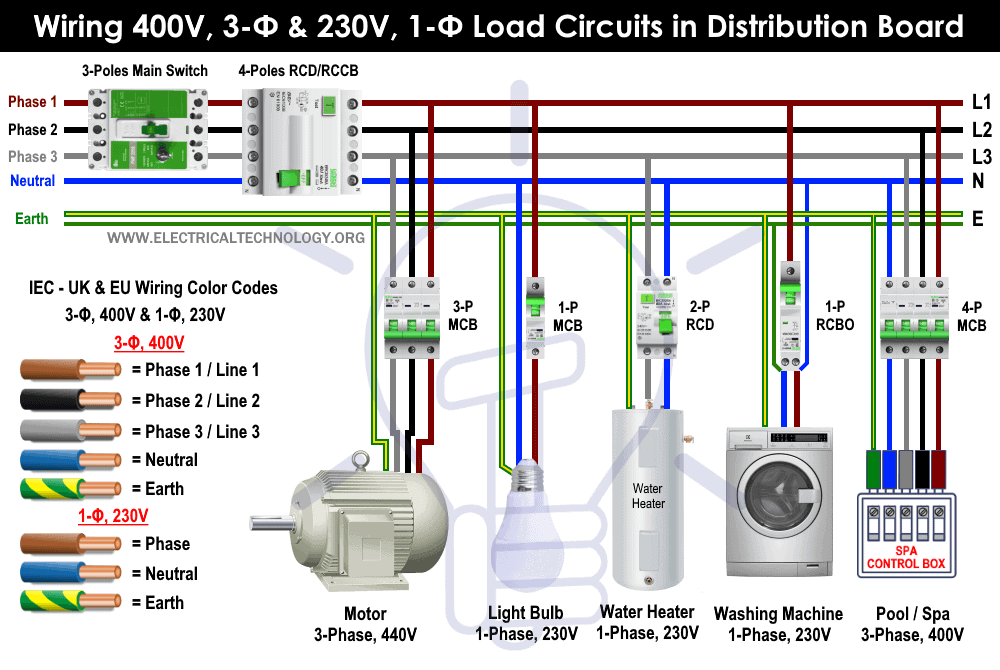How to Wire Combo of 3 & 1-Φ, 400V/230V Distribution Board?
Wiring a Combination of 1-Phase & 3-Phase , 230V/400V Distribution Board: IEC-EU & UK
What is a Distribution Board?
A distribution board (also known as electric panel, breaker panel, panelboard, main breaker-box or main service panel) is a combination of protection devices and components used to safely control and distribute the power supply to the electrical appliances. It contains multiple protective devices such as Main switch, MCB, MCCB, RCD, RCBO, Isolator, Fuses and Switches etc.
Distribution boards are motley used in industrial, and commercial as well as domestic and residential application. It can be used for three phase 400V AC, single phase 230V or both single phase and three phase supply i.e. 400V & 230V utilization and applications.
Related Posts:
- How to Wire 1-Phase Split Load Consumer Unit? – RCD+RCBO
- How to Wire 230V Dual Split Load Consumer Unit? – RCD+MCB
Following are the different types of distribution boards used for 3-Phase & 1-Phase supply in industrial and residential applications.
- Main Distribution Board: It is the first and main breaker box connected to the 3 Phases and 1 Neutral service cable from the secondary of the distribution transformer installed on the utility pole. Before entering the main panel box, the service cable is connected to the three phase energy meter and an isolator switch.
- Sub Distribution Board: It is a type of secondary distribution board fed up by the main distribution board to provide power supply within a selected area in a building such as a specific flour in a multistorey building.
- Final Distribution Board: As the name suggests, It is a type of distribution board which is used to provide electric supply to the single and three phase final and sub final circuits such as the switchboard in a room for lighting and ceiling fan control etc. or three phase motors control panel.
In this tutorial, we will show how to wire a combination of single phase and three phase distribution board and connect the load to different points with the help of multiple protective components.
Related Post: How to Wire Single-Phase, 230V Consumer Unit with RCD? IEC, UK & EU
Single Phase & Three Phase Supply in the UK & EU
In a single phase supply system, all the voltages have the same sinusoidal pattern and require only two wires to complete the circuit. While in a three phase power supply system, there are 3 sinusoidal voltages having 120° phase difference and requires either 3 or 4 conductors depending on the configuration.
In a single phase power system, the supplied voltage is equal to the voltage difference between phase and neutral i.e. 230V. In three phase power system, the phase to phase voltage is equal to √3 times the phase voltage i.e. 400V. While any Phase to Neutral voltage is equal to single phase voltage.
In the power distribution system for residential and commercial applications, the 11kV power is supplied by the Delta connected transformer. The secondary winding of this transformer is connected to the primary side (in Delta) of the distribution transformer mounted on the utility pole. The secondary of the distribution transformer is wires in Y or Star connection. This way, the stepped-down voltage (from 11kV to 400 & 230V) can be achieved as follows.
- Voltage between Phase (or any Line) to Neutral = 230V AC Single Phase
- Voltage between Three Phases (Lines) = 400V AC Three Phase
For both single and three phase supply systems, the four wires (three as Phases and one as Neutral)
Most countries follow the same voltage levels for both single phase and three phase supply systems used in the UK and EU. On the other hand, residential and commercial supply voltage is totally different from the IEC. For example:
Single Phase Voltage in UK & EU
- Phase to Neutral = 230V
Three Phase Voltage in UK & EU
- Phase to Phase = 440V
- Any Phase to Neutral = 230V Single Phase
- Between Three Phase = 440V Three Phase
Single Phase Voltage in US & Canada
- Hot to Neutral = 120V,
- Hot to Neutral = 208V, (high leg delta)
- 2 Hot = 240V (split phase),
- Hot to Neutral = 277V
- Hot to Neutral = 480V
Three Phase Voltage in US & Canada
- Three Hots = 208V
- Three Hots = 240V
- Three Hots = 480V
Related Posts:
- Single Phase Electrical Wiring Installation in Home – NEC & IEC
- Three Phase Electrical Wiring Installation in Home – NEC & IEC
Good to Know:
Balanced & Unbalanced Load in the 3-Phase & 1-Phase System
In a three phase balanced load system, All the load can be connected directly to the three lines without Neutral. On the other hand, Neutral is needed in the unbalanced load system. It is because the Neutral is used to return the unbalanced current through it to the supply system, but these loads like motors and water heaters are designed with consistent power factor and have the same impedance and resistance on each line. This way, the resultant current is almost zero hence it doesn’t need to connect the Neutral wire with three lines.
In case of an unbalanced load system (which leads to unstable voltage and unexpected current which may lead to system failure and even there is a risk of electric shock as well), the neutral is used to return the unbalanced current to the source of supply voltage.
Now let’s see how to manage the three phase and single phase load circuits in a 230V/400V distribution board.
Related Posts:
- Single-Phase Electrical Wiring installation in a Multi-Story Building
- 3-Phase & 1-Phase Electrical Distribution Wiring Installation in Multistory Building
How to Wire a 1-Phase Load in a Distribution Board?
As discussed early, a single phase load can be connected between any Phase (out of three) and Neutral. In other words, the single phase. The 230V load circuit can be connected via Phase, Neutral and Earth/Ground wire. Keep in mind that it is good practice to avoid unbalanced system i.e. it is recommended to not install all the single phase loads to the same Phase or Line (i.e. L1, L2 or L3).
As shown in the fig-1 for combo of single phase and three phase distribution board, the single phase loads are connected through RCD, MCB and RCBO as follows.
On the Right side of the breaker bank
- Three 1-pole MCB’s
- Two 1-pole RCBO’s
- One 2-Poles RCD
On the Left side the breaker bank
- Two 1-pole MCB’s
- One 1-Pole RCBO
Related Posts:
- How to Wire 240V, 208V & 120V, 1 & 3-Phase, High Leg Delta Main Panel?
- How to Wire 277V & 480V, 1-Phase & 3-Phase, Commercial Main Service Panel?
How to Wire a 3-Phase Load in a Distribution Board?
The three phase load can be directly connected to the three poles or four poles breaker, RCBO or RCD. Keep in Neutral is also needed in some cases for three phase load systems.
For example, a three phase motor and other balanced load can be directly connected to three phases (L1, L2 & L3) and earth wire. On the other hand, Neutral is needed to return the unbalanced current in case of an unbalanced system.
The following fig-1 shows the three phase loads wiring for the 440V supply system.
On the Right side of the breaker bank
- One 3-poles MCB’s
On the Left side the breaker bank
- One 3-poles MCB’s
- One 4-poles RCD
Click image to enlarge
400/230V Distribution Board Wiring – Old UK Wiring Color Codes
As most countries (like India, Pakistan, Philippine, UAE etc.) still follow the old UK wiring color codes (prior 2004) for both single phase and three phase supply systems. The same wiring connection as above for both 1-Φ & 3-Φ load points is shown below with Old UK wiring color codes.
Click image to enlarge
Related Posts:
- How to Wire 120V & 240V Main Panel? Breaker Box Installation
- How to Wire 208V & 120V, 1-Phase & 3-Phase Main Panel?
Wiring 400V, 3-Φ & 230V, 1-Φ Load Circuits in Distribution Board
In a combination of single phase and three phase distribution board (400V/230V) , the single phase, 230V load circuits should be connected via three wires i.e. Phase (Any hot or line), Neutral and Protective Earth to the Earthing/Grounding. In single phase supply, the voltage between phase and neutral is 230V AC.
A three phase load can be directly connected to all three phases (Voltage between all three phases are 440V). Keep in mind that Neutral is not always necessary in this configuration. For example, a three phase motor is directly connected to three lines without Neutral wire. While in case of spa and pool, Neutral wire is needed with all three phases. For proper wiring installation, Please refer to the appliances and user manual guide provided by the manufacturer or contact a licensed electrician.
In the following fig, the protection to the single phase and three phase load circuits are as follows.
Single Phase 230V Loads
- Light Bulb via Single Pole MCB
- Washing Machine via Single Pole RCBO
- Water Heater via Two Poles RCD
Three Phase 400V Loads
- 3-Phase Motor via Three Poles MCB (Three Wires)
- 3 Phase Spa & Pool Control (Five Wires i.e. Three Phases, 1 Neutral & 1 Ground)
IEC Wiring Color Codes – 3 & 1-Φ, 400V/230V: UK & EU
We have used the following IEC wiring color codes for 400V three phase and 230V single phase supply voltage applicable in the UK & EU.
IEC Wiring Color Codes for 400V, 3-Phase, 4-Wire System
- Brown = Line 1 or Phase 1
- Black = Line 2 or Phase 2
- Gray = Line 3 or Phase 3
- Blue = Neutral
- Green or Green with Yellow Stripe = Earth or Ground wire as protective earth (PE).
IEC Wiring Color Codes for 230V, 1-Phase, 2-Wire System
- Brown = Line or Phase Wire
- Blue = Neutral
- Green or Green with Yellow Stripe = Earth or Ground wire as protective earth (PE).
The Old UK wiring color codes for single phase and three phase wiring.
400V Three Phase
- Red = Phase 1
- Yellow = Phase 2
- Blue = Phase 3
- Black = Neutral
- Green = Earth or Ground wire.
230V Single Phase
- Red = Phase
- Black = Neutral
- Green = Earth or Ground wire.
Related Posts:
Instruction & Safety Precautions
- Disconnect the power supply (and make sure it is really swathed OFF) before servicing, repairing or installing electrical equipment. To do so, switch off the main switch in the main consumer unit or distribution board.
- Never stand or touch wet and metal parts while repairing or installation.
- Read carefully all the cautions and instructions and follow them strictly while doing this tutorial or any other work in practical related to electrical works.
- Always, use the right size cable and wire, proper size outlets and switch and suitable size of circuit breakers. You may also use the Wire and Cable size calculator to find the right gauge size.
- Never ever try to play with electricity (as it is dangerous and can be fatal) without proper guidance and care. Do the installation and repairing work in presence of experienced persons having vast knowledge and good practice who knows how to deal with electricity.
- Doing your own electrical work is dangerous as well as illegal in some cases. Contact the licensed electrician or the electric power supply provider before practicing any change/modification in electrical wiring connections.
- The distribution board should not be installed 2.2 meter above the floor, must be protected from the corrosion and away from watery areas. All the wires should be covered in the panel board (i.e. it should not hang outside the panel). Finally, there must be a safety sign near the distribution board.
- The author will not be liable for any losses, injuries, or damages from the display or use of this information or if you try any circuit in wrong format. So please! Be careful because it’s all about electricity and electricity is too dangerous.
Related Wiring Installation Tutorials:
- How to Wire and Install an Electrical Outlet Receptacle?
- How to wire a GFCI Outlet?
- How to Wire an AFCI Outlet?
- How to Wire Combo Switch and Outlet?
- How to Wire GFCI Combo Switch and Outlet
- How to Wire an AFCI Combo Switch
- How to Wire a GFCI Circuit Breaker?
- How to Wire an AFCI Breaker?
- Staircase Wiring Circuit Diagram – How to Control a Lamp from 2 Places?
- Corridor Wiring Circuit Diagram – Hallway Wiring using 2-Way Switches
- Tunnel Wiring Circuit Diagram for Light Control using Switches
- Hospital Wiring Circuit for Light Control using Switches
- Hotel Wiring Circuit – Bell Indicator Circuit for Hotelling
- Hostel Wiring Circuit Diagram and Working
- Godown Wiring Diagram – Tunnel Wiring Circuit and Working
- How to Wire 120V Water Heater Thermostat – Non-Simultaneous?
- Even More Electrical Wiring Installation & Tutorials










